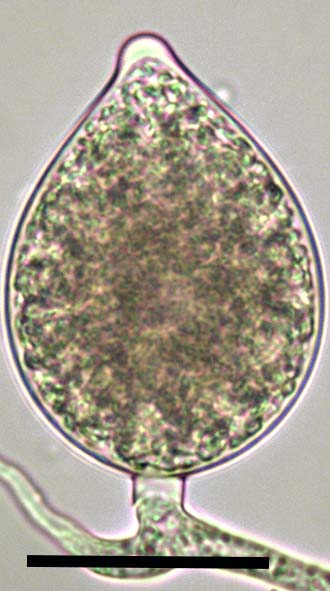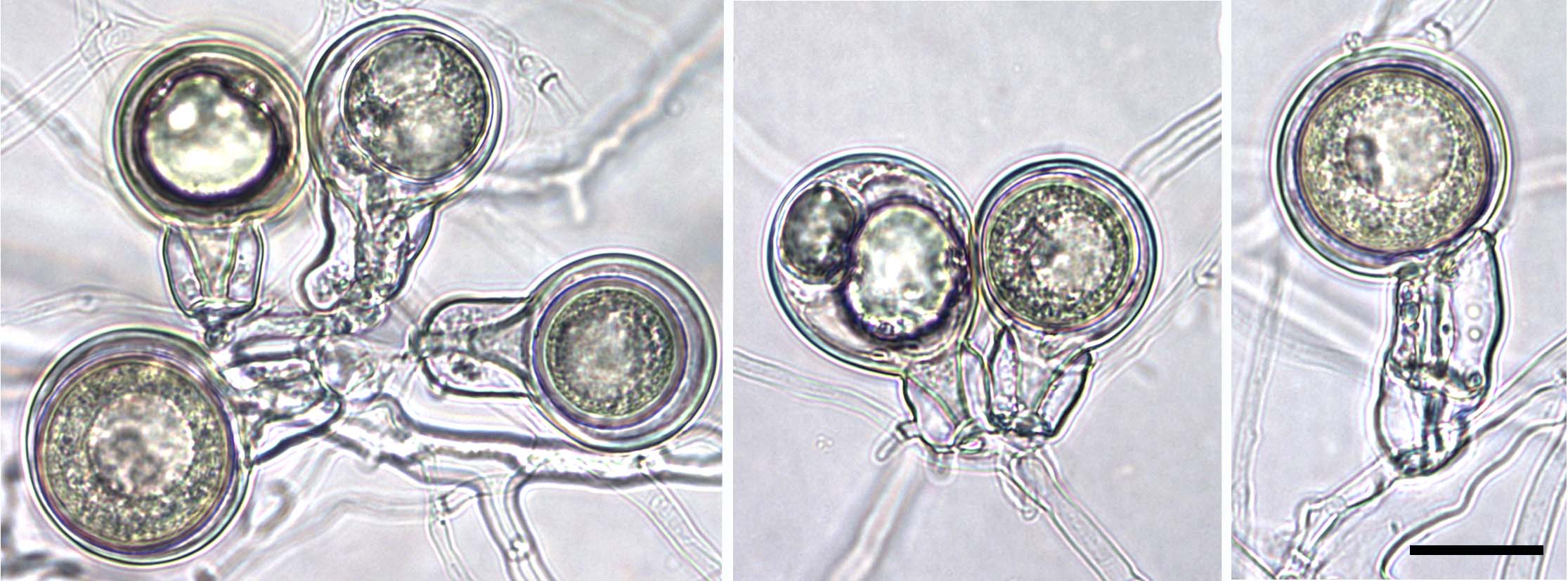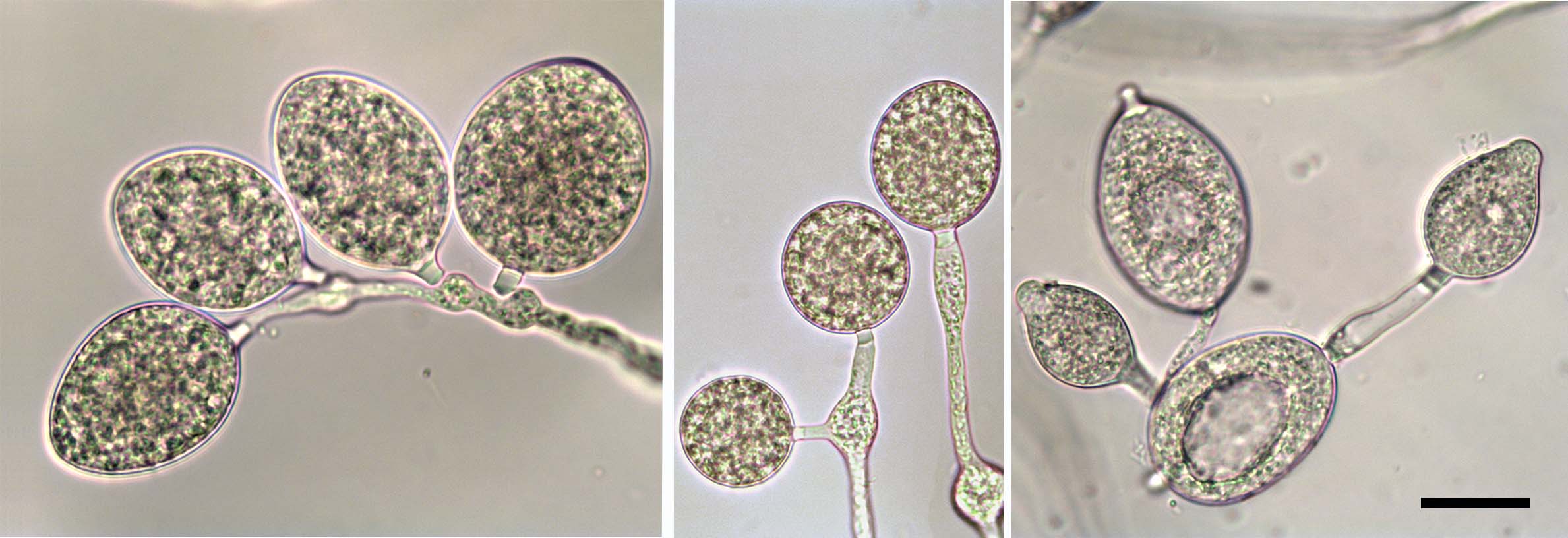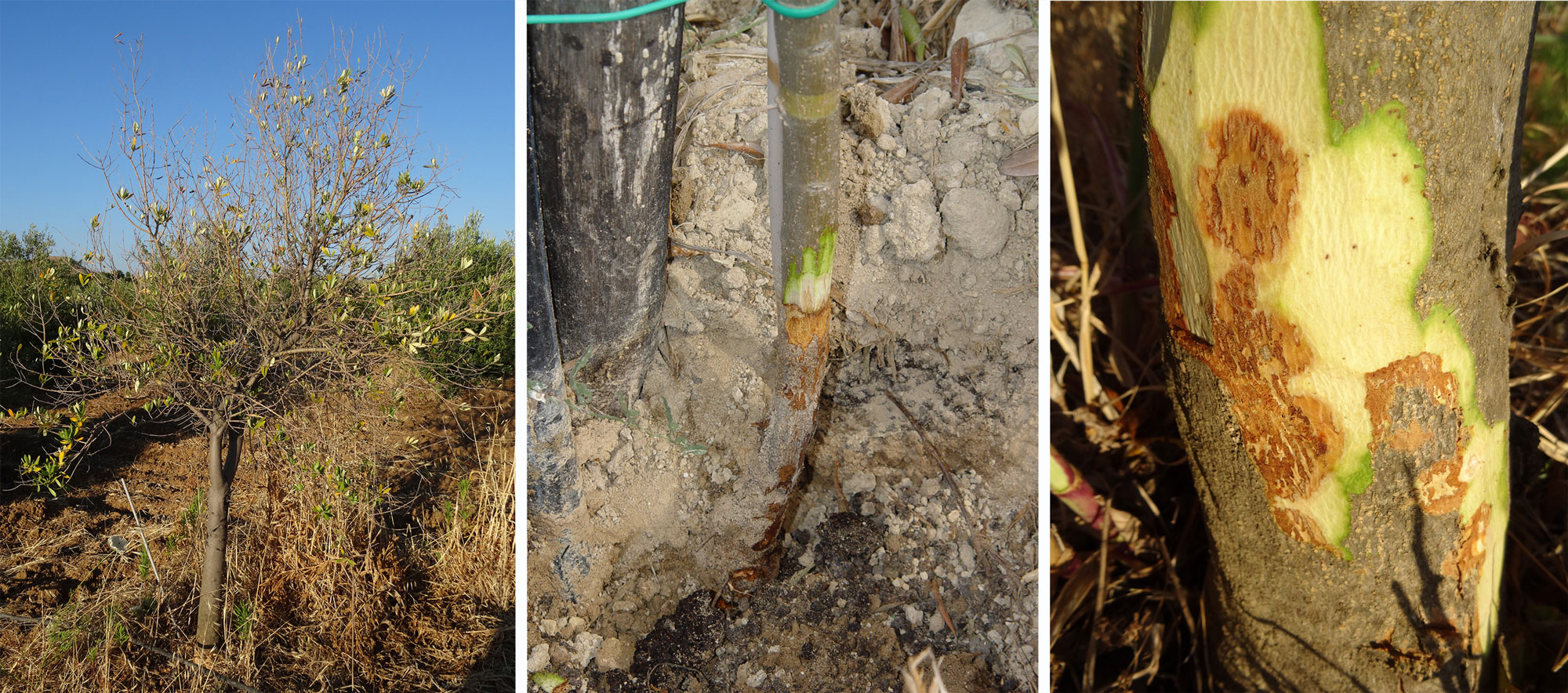Phytophthora heterospora
|
Phytophthora spp. in Clade 4: portion of the seven-loci ML phylogeny featuring the type cultures of 212 described species (by T. Bourret). Notice the position of P. heterospora Ex-type CBS 148034 = S&T BL 119. Gloria Abad, USDA S&T.
|
|
Phytophthora spp. in Clade 4: Morphological Tabular key (PDF) and Tabular key legends (PDF) in IDphy2 KEY SECTION. Notice the data of P. heterospora Ex-type CBS 148034 = S&T BL 119. Gloria Abad, USDA S&T.
|
|
colony morphology after 4 d growth at 20 ºC in the dark on carrot agar, V8A, CA, MEA, and PDA (from left to right) |
|
laterally attached papillate sporangium; scale bar = 25µm |
|
oogonia globose with aplerotic oospores, short tapering bases, often with aborted oospore; antheridia bicellular and often with finger-like projection (from left to right); scale bar = 25 μm |
|
ovoid pseudoconidia forming monochasial helicoid sympodia, still attached to the conidiophores or recently detached with nodose swellings at the insertion points of the pseudoconidia to the conidiophores; spherical to ovoid pseudoconidia with short pre-formed pedicels; ovoid, laterally attached papillate sporangium; pseudoconidia germinating by forming papillate microsporangia and a new conidium (from left to right); scale bar = 25µm |
|
disease symptoms on Olea europaea: 4-year-old tree showing chlorosis and increased transparency of the crown; orange-brown and flame shaped lesions on the stem; single-spot bark lesions on the main stem |
Name and publication
Phytophthora heterospora Scanu, Cacciola, Linal. & T. Jung (2021)
Scanu B, Jung T, Masigol H, Linaldeddu BT, Jung MH, Brandano A, Mostowfizadeh-Ghalamfarsa R, Janoušek J, Riolo M, Cacciola SO. 2021. Phytophthora heterospora sp. nov., a new pseudoconidia-producing sister species of P. palmivora. Journal of Fungi 7: 870.
Corresponding author: bscanu@uniss.it
Nomenclature
Mycobank
Etymology
The name refers to the production of a variety of different spores including pseudoconidia, zoospore-releasing sporangiasporangia:
sac within which zoospores form, especially when water is cooled to about 10°C below ambient temperature; in solid substrates, sporangia usually germinate by germ tubes
, chlamydosporeschlamydospores:
an asexual spore with a thickened inner wall that is delimited from the mycelium by a septum; may be terminal or intercalary, and survives for long periods in soil
, and oosporesoospores:
zygote or thick-walled spore that forms within the oogonium after fertilization by the antheridium; may be long-lived
.
Typification
Type: Italy, Sardinia, Sorso, from a bark lesion on a young olive tree, 2010, collected by B. Scanu type CBS H-24777
Ex-type: culture CBS 148034 = PH054
Sequences for ex-type in original manuscript: CBS 148034 = PH054; ITS MT232393, β-tubulin MZ782807, cox1 MZ782828, HSP90 MZ782849
Ex-type in other collections
(ET) CBS 148034, PH054 (Scanu), S&T BL 119 (Abad)
Molecular identification
Voucher sequences for barcoding genes (ITS rDNA and COI) of the ex-type (see Molecular protocols page)
Phytophthora heterospora ITS rDNA, COI
Voucher sequences for Molecular Toolbox with seven genes (ITS, β-tub, COI, EF1α, HSP90, L10, and YPT1
(see Molecular protocols page) (In Progress)
Voucher sequences for Metabarcoding High-throughput Sequencing (HTS) Technologies [Molecular Operational Taxonomic Unit (MOTU)]
(see Molecular protocols page) (In Progress)
Sequences with multiple genes for ex-type in other sources
- NCBI: Phytophthora heterospora
- EPPO-Q-bank: Phytophthora heterospora
- BOLDSYSTEMS: Phytophthora heterospora
Position in multigenic phylogeny with 7 genes (ITS, β-tub, COI, EF1α, HSP90, L10, and YPT1)
Clade clade:
a taxonomic group of organisms classified together on the basis of homologous features traced to a common ancestor
4
Morphological identification
Colonies and cardinal temperatures
Colony colony:
assemblage of hyphae which usually develops form a single source and grows in a coordinated way
morphology radiate with limited aerial myceliummycelium:
mass of hyphae constituting the body, or thallus, of fungi and oomycetes; in <em>Phytophthora</em> species, mycelia is coenocytic
on CA and V8A, uniform and slightly woolly on PDA, and poorly developed, dense-felty with irregular margin on MEA. Minimum growth temperature 12°C, optimum 27.5°C, and maximum 32.5°C.
Conditions for growth and sporulation
Sporangia and pseudoconidia are produced in water cultures (soil extract) and in solid media. OogoniaOogonia:
the female gametangium in which the oospore forms after fertilization by the antheridium
are formed readily when paired with known A1 and A2 tester strains of P. cinnamomi and P. palmivora on CA about 20 days.
Asexual phase
SporangiaSporangia:
sac within which zoospores form, especially when water is cooled to about 10°C below ambient temperature; in solid substrates, sporangia usually germinate by germ tubes
were papillatepapillate:
pertaining to the production of a distinct papilla at the distal end of the sporangium (cf. nonpapillate and semipapillate)
, caducouscaducous:
pertaining to sporangia that become dislodged readily (i.e. deciduous) and separate from the sporangiophore (cf. persistent)
with a short pedicelpedicel:
the hyphal base of a sporangium that remains attached after the sporangium separates, or is shed, from the sporangiophore; the pedicel may be short (< 5 µm), medium (5–20 µm), or long (> 20 µm)
<5 μm, and predominantly ovoidovoid:
egg-shaped, with the widest part at the base of the sporangium and the narrow part at the apex
in shape with external proliferationexternal proliferation:
formation of a sporangium after a sporangiophore has emerged from beneath and external to an empty sporangium that has previously emitted its zoospores (cf. internal proliferation)
. SporangiaSporangia:
sac within which zoospores form, especially when water is cooled to about 10°C below ambient temperature; in solid substrates, sporangia usually germinate by germ tubes
averaged 42.8 × 24.7 µm (overall range 15.6–72.6 x 12.4–42 µm); Sporangiophores simple or loose sympodiasympodia:
a type of sporangiophore which appears simple, but where each successive sporangium develops on a branch behind and to one side of the previous apex, where growth has already ceased
. Pseudoconidia were caducouscaducous:
pertaining to sporangia that become dislodged readily (i.e. deciduous) and separate from the sporangiophore (cf. persistent)
and predominantly ellipsoidellipsoid:
refers to a solid body that forms an ellipse in the longitudinal plane and a circle in cross section; many fungal spores are ellipsoidal or elliptic
in shape with external proliferationexternal proliferation:
formation of a sporangium after a sporangiophore has emerged from beneath and external to an empty sporangium that has previously emitted its zoospores (cf. internal proliferation)
at base forming monochasial helicoid sympodiasympodia:
a type of sporangiophore which appears simple, but where each successive sporangium develops on a branch behind and to one side of the previous apex, where growth has already ceased
. They do not produce zoosporeszoospores:
motile spore that forms within the sporangium and exits through the exit pore and is capable of swimming for several hours; it has both a tinsel flagellum and a whip-like flagellum
but germinate directly. Pseudoconidia dimension averaged 34.7 × 27.1 μm (overall range 24.0–44.2 × 16.5–27.1 μm).Hyphal swellings present. ChlamydosporesChlamydospores:
an asexual spore with a thickened inner wall that is delimited from the mycelium by a septum; may be terminal or intercalary, and survives for long periods in soil
present, abundant.
Sexual phase
Heterothallic. OogoniaOogonia:
the female gametangium in which the oospore forms after fertilization by the antheridium
had smooth walls and often with a short tapering base, size ranged from 24.3–37.4 µm. OosporesOospores:
zygote or thick-walled spore that forms within the oogonium after fertilization by the antheridium; may be long-lived
apleroticaplerotic:
pertaining to a mature oospore that does not fill the oogonium; i.e. there is room left between the oospore wall and oogonium wall (cf. plerotic)
, size ranged 20.2–31.4 µm. OosporesOospores:
zygote or thick-walled spore that forms within the oogonium after fertilization by the antheridium; may be long-lived
often aborted after formation of the walls. AntheridiaAntheridia:
the male gametangium; a multinucleate, swollen hyphal tip affixed firmly to the wall of the female gametangium (the oogonium)
amphigynousamphigynous:
pertaining to the sexual stage in which the antheridium completely surrounds the stalk of the oogonium (cf. paragynous)
.
Most typical characters
Phytophthora heterospora is a sister species to P. palmivora but differs by the production of pseudoconidia on solid agar media. Other key differences are the lower maximum temperature for growth and faster growth rates at most temperatures of P. heterospora and the higher oosporeoospore:
zygote or thick-walled spore that forms within the oogonium after fertilization by the antheridium; may be long-lived
abortion rate of P. heterospora. Many sequences submitted to Genbank as P. palmivora are identical to P. heterospora.
Additional specimen(s) evaluated
ITALY, Sardinia, Villamar, from Olea europaea, 2010, B. Scanu, CBS 148035 = PH051; PH052; PH057; Sorso. PH047; Sicily, Catania, from Capparis spinosa, 2014, S.O. Cacciola, CBS 148036 = 317-A12; Campobello di Mazara, from Olea europaea, 2005, Campobello 2b; Calabria, Lamezia Terme, from Olea europaea,1999, Palm2. Vietnam, Mekong Delta, Vinh Long, necrotic bark lesions on Durio zibethinus trees, 2013, S.O. Cacciola, DB2; A1A; A1B1; C2B1
Hosts and distribution
Distribution: Italy, Iran, Vietnam
Substrate: stems and roots
Disease note: stem lesions, root and collar rot of young olive trees
Host: Olea europaea, Ziziphus spina-christi, Juniperus oxycedrus, Capparis spinosa, Durio zibethinus
Additional references and links
- SMML USDA-ARS: Phytophthora heterospora
- EPPO Global Database: Phytophthora heterospora
- Forest Phytophthoras of the World: Phytophthora heterospora
- CABI Digital Library: Phytophthora heterospora
- Encyclopedia of Life (EOL): Phytophthora heterospora
- Index Fungorum (IF): Phytophthora heterospora
Fact sheet authors
Bruno Scano and Treena Burgess
Z. Gloria Abad, Ph.D., USDA-APHIS-PPQ-S&T Plant Pathogen Confirmatory Diagnostics Laboratory (PPCDL), United States of America.






